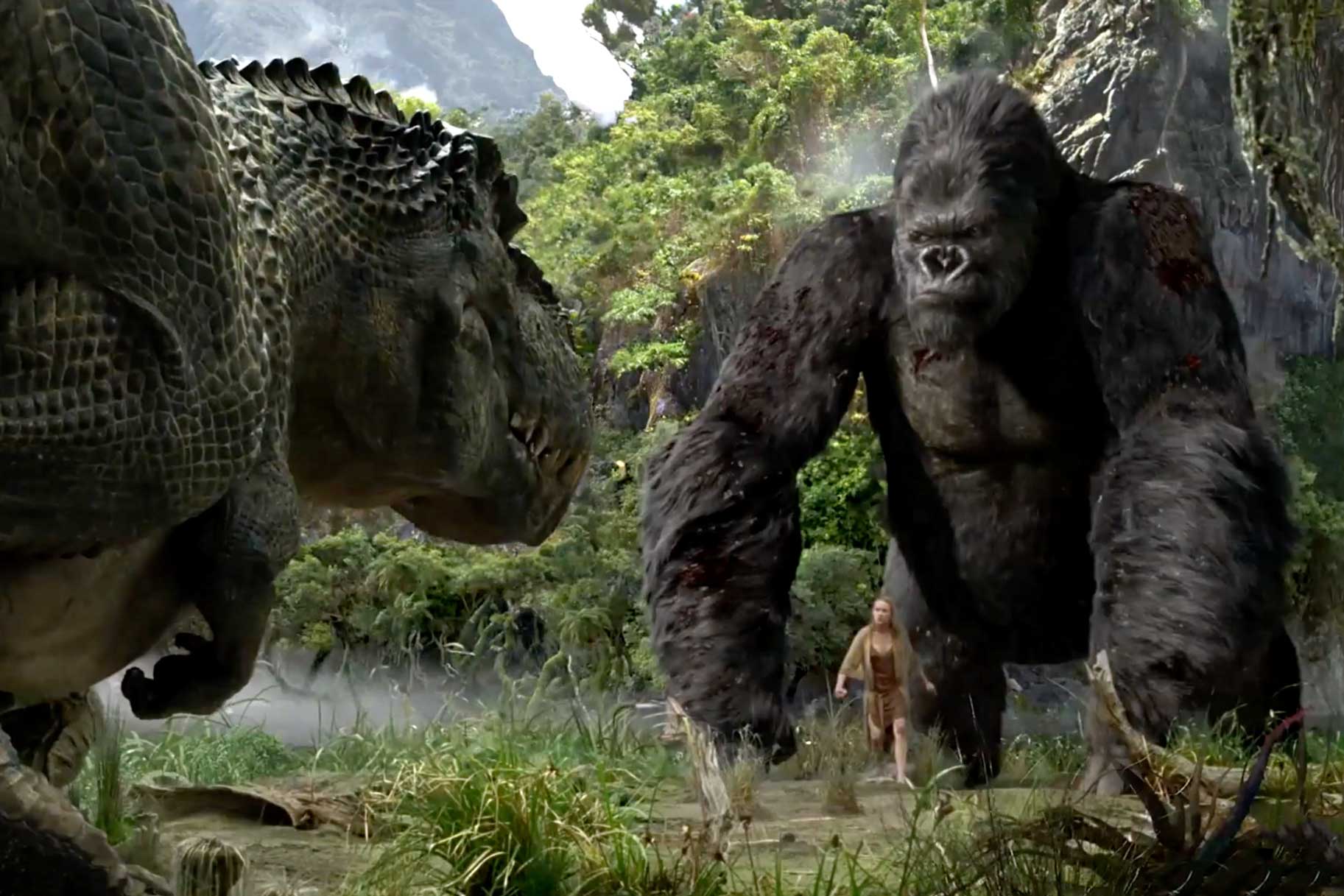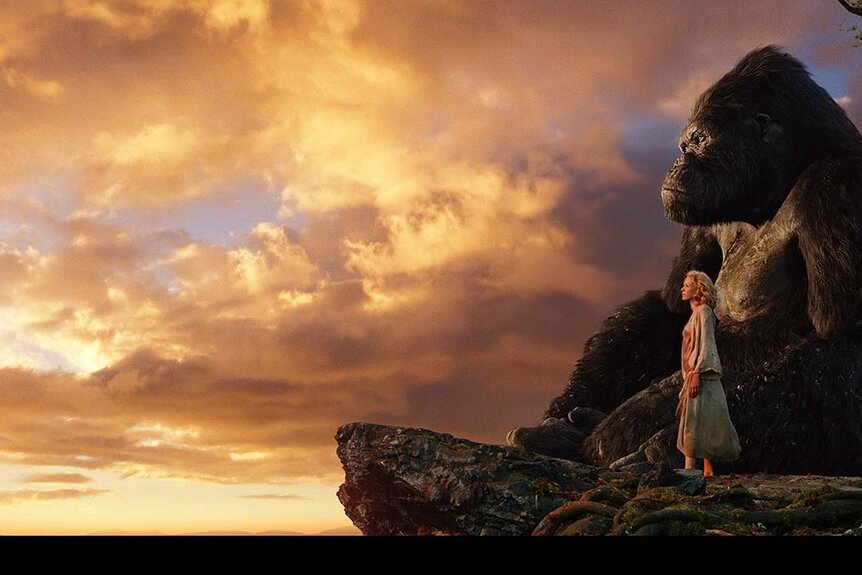Create a free profile to get unlimited access to exclusive videos, sweepstakes, and more!
Can Island Gigantism Explain the Overgrown Size of King Kong?
If you want to become a giant, move to an island.

There are few fictional creations as enduring as the lumbering but loveable King Kong. Following the runaway success of the Lord of the Rings trilogy, director Peter Jackson turned his attention to reimagining Skull Island and its primate king in the 2005 action-adventure King Kong (streaming now on Peacock). Naomi Watts, Jack Black, Adrian Brody, and Andy Serkis star as the vaudeville actress Ann Darrow, film director Carl Denham, screenwriter Jack Driscoll, and the titular Kong, respectively.
The story takes place in the midst of the Great Depression, everyone is looking for a break and they find it on Skull Island. Once there, Darrow is captured by the indigenous peoples and given to Kong as an offering. Far from a mindless monster, Kong becomes enamored with Darrow, revealing a heart even larger than the one you might expect.
Of course, Kong isn’t the only oversized creature on the island. While attempting to recover Darrow from Kong’s clutches, the party encounters a number of towering insects and dinosaur-like creatures. Almost everything on Skull Island is bigger than it should be and the only unifying factor among them is the place they call home.
For More on Giant Animals:
Scientists Discover New Species of Super Jacked Ancient Kangaroo
The Ancient World Looked a Lot Like Middle-Earth with 'Hobbit' Humans and Giant Birds
Ichthyosaurs Underwent Rapid Expansion to Become the World's First Giants
Island Gigantism, How Isolated Species Become Giants
Though it wasn’t named in the original films, Skull Island has appeared as the home of Kong and Friends since 1933. Over time, it has had a number of names including Skull Mountain Island or simply Kong’s Island, and it has been home to tyrannosaurus and other theropod dinosaurs, stegosaurus, triceratops, cave bears, giant piranha, giant bats, and more. Skull Island has also been home to a variety of invented megafauna including skullcrawlers, death jackals, and magma turtles with trees growing out of their shells.
The location, shape, and characteristics of Skull Island vary from telling to telling, but whether it’s nestled in the Bermuda Triangle or shrouded in fog off the coast of India, all that really matters is it’s isolated.
In 1964, biologists J. Bristol Foster published a paper titled “Evolution of Mammals on Islands,” in the journal Nature. In it, he proposed what has become known as the island rule, which describes the way species dramatically change size when isolated. Foster compared 116 island-dwelling species with their mainland counterparts and found that most of them had either grown dramatically smaller (island dwarfism) or dramatically larger (island gigantism).
In general, Foster found that species which begin small tend to get bigger and species which begin big tend to get smaller. He also found that large carnivorous predators tend to disappear on islands, owing to a lack of sufficient prey and range. When large predators disappear, their niches become available and smaller animals grow rapidly to fill them.
In the real world, we see island gigantism in the giant tortoises of the Galapagos, the giant dragons of Komodo, and the now-extinct New Zealand Moa. Being big on an island might sound like a recipe for disaster but it comes with a wide range of benefits. Larger size makes you less vulnerable to predation and better able to handle a lack of resources. You can tolerate longer periods without food and water, and you can cover larger distances in search of resources.
In the decades since Foster first introduced the island rule, we’ve learned a bit more about what drives a species toward gigantism or dwarfism. Territorial animals are more likely to favor large sizes, because bigger bodies help them better defend large areas, but it’s more complicated than that. In fact, a species might go for gigantism on one island and dwarfism on another, it all depends what niches are available and how best a species can take advantage of them.
Given that gorillas are already large, they might trend toward smaller sizes in an island environment. However, they are territorial herbivores, which might favor keeping their large size or growing larger. Whether a gorilla-like ape species would grow even larger or shrink in size once isolated on Skull Island depends on a lot of factors, but it’s unlikely that they could get as large as Kong.
Gigantopithecus, the Largest Ape Who Ever Lived
The largest known ape in the history of our planet was Gigantopithecus, a gigantic primate which lived in southern China between 2 million and 200,000 years ago. They are known only from a handful of lower jaws and scattered teeth. Based on those few fossils, we believe it was a herbivore, specializing on fibrous plant material and figs.
It’s often reconstructed as gorilla-like, 10 feet tall, and weighing up to 660 pounds. In truth, we know very little about what it might have looked like, how it might have behaved, and even how large it might have been. The size of the jaw and molars give us some clues, but they aren’t enough to definitively tell us how big Gigantopithecus was. We know for sure that it wasn’t 25 feet tall, and it didn’t fight dinosaurs.
Island gigantism probably plays a part in the overclocked bods of the animals on Skull Island, but Kong’s kingdom might be too weird to be explained by science. If we want to truly unravel this puzzle, we might have to go there ourselves.
Visit Skull Island in Kong Kong (2005), streaming now on Peacock.




























